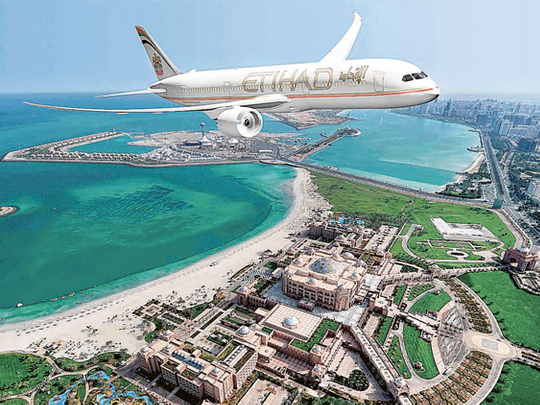
Dubai: Etihad Airways said Wednesday revenues jumped 28 per cent in the first half of this year to $1.72 billion (Dh6.31 billion) over the same period last year as passenger and cargo traffic increased.
The numbers have put the Abu Dhabi-based carrier closer to its goal of achieving breakeven this year and profitability in 2012.
Cargo operations, meanwhile, climbed 32 per cent in revenues in the first half as tonnage and yields improved.
A two per cent reduction in costs per available seat kilometre, despite large increases in oil prices, also helped the airline deliver positive earnings before interest, tax, depreciation, amortisation and rentals in the six months to June 30, 2011 for the first time.
Asked how big a role hedging played in the airline's first-half performance, Etihad Chief Executive James Hogan told Gulf News: "In the first six months of the year we were 80 per cent hedged on fuel, which provided solid shelter from the steep rises this year." He called this year's first half as the airline's "most successful".
In right direction
A challenging first six months saw revenues of most regional and global carriers erode amidst the Middle East geo-political unrest, natural disasters in Japan and oil prices playing havoc. Despite this, Hogan said the airline managed to raise its first-half passenger revenues by 21 per cent backed by a 14 per cent jump in passenger numbers to 3.8 million, and a five per cent growth in passenger yield.
As Ernest S. Arvai, President and CEO of The Arvai Group, an aviation consultancy, points out: "Clearly, Etihad is moving in the right direction and remains on target with its EBITDAR profit. A fundamental difference between Etihad and the other Gulf carriers is its collaborative approach to cooperating with other airlines."
The carrier's seat factor, meanwhile, surged 72.9 per cent in the first six months of the year compared with 72.5 per cent in the same period in 2010.
Asked how the carrier managed to yield positive results while other carriers were suffering losses in first half, Hogan said: "Our business is growing into scale. By that we mean that our revenues and capacity are rising at a greater rate than the costs of infrastructure, administration and normal overheads," adding that the benefits of Etihad's cost reduction programme had a "positive impact".
Impact of oil prices
Projecting Etihad's performance in the second half of 2011, Frost & Sullivan's Aerospace and Defence analyst, told Gulf News: "If the impact of oil prices continues to be negligible on Etihad, the carrier can foresee revenue increases in the second half of the year as well. This will further make it closer to achieving breakeven targets." Added Arvai: "With additional deliveries and projected growth in both passenger and cargo operations, we believe that Etihad has mapped out an achievable plan."
The carrier last week struck its most comprehensive deal spanning a 10-year period worth £400 million (according to the British media) with Manchester City, which amongst other things, saw the City of Manchester Stadium renamed Etihad Stadium. "The business is maturing with each passing year. The growing pains of our initial years are less pronounced," Hogan pointed out.
Shrugging off poor market conditions, Etihad said it is determined to significantly expand its global network. With the carrier having announced last week flights to two new Chinese cities, Shanghai and Chengdu — the carrier's 69th destination, it is set to start services to Male and the Seychelles starting on November 1.
Etihad said it was able to up its frequencies to several major markets this summer as it adds five new wide-body passenger aircraft — three A330-300s and two B777-300ERs to its fleet, which currently stands at 63 Airbus and Boeing planes, with 100 aircraft on order, including 10 Airbus A380s.
Hogan reportedly said earlier this month that the airline will take deliveries of "92 planes by the end 2012", resulting in a fleet of 155 aircraft.










